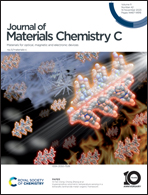Back in bismuth: controlling triplet energy transfer, phosphorescence, and radioluminescence via supramolecular interactions†
Abstract
Five bismuth(III)-organic phases that consist of supramolecular assemblies of Bi-2,6-pyridinedicarboxylate structural units and substituted 1,10-phenanthroline molecules (R-Phen; R = H, 5-methyl, 5-chloro, 2,9-dimethyl, and 2,9-dicholoro) were synthesized. All five compounds exhibited solid-state photoluminescence. Whereas the phases containing 2,9-dimethylphenanthroline (Me2Phen) and 2,9-dichlorophenanthroline (Cl2Phen) displayed solely phosphorescence, the structures built from 5-methylphenanthroline and 5-chlorophenanthroline showed exclusively fluorescence. The remaining phase, consisting of phenanthrolinium, exhibited both fluorescence and phosphoresence. It was determined that phosphorescence arises from triplet state emission (T1 → S0) of substituted R-Phen units while fluorescence originates from Bi(III) coordinated pyrdinedicarboxylate ligands. Bismuth induces spin–orbit coupling for triplet state population and additionally acts as a heavy metal attenuator for X-ray luminescence (radioluminescence). The electronic structure was mapped and excitation pathway investigated via density functional theory calculations. Computational findings indicate favorable conditions for triplet energy transfer from donor Bi(III)-organic units to acceptor R-Phen derivatives. It is proposed that for the phosphorescent compounds, strong π–π interactions promote electron transfer, whereas the compounds that exhibit purely fluorescence lack any such π–π interactions and undergo triplet energy transfer. These results provide a useful platform for probing structure–property relationships of luminescent bismuth-organic compounds, and specifically highlights the role of noncovalent interactions in achieving room temperature phosphorescence and radioluminescence.

- This article is part of the themed collection: #MyFirstJMCC


 Please wait while we load your content...
Please wait while we load your content...